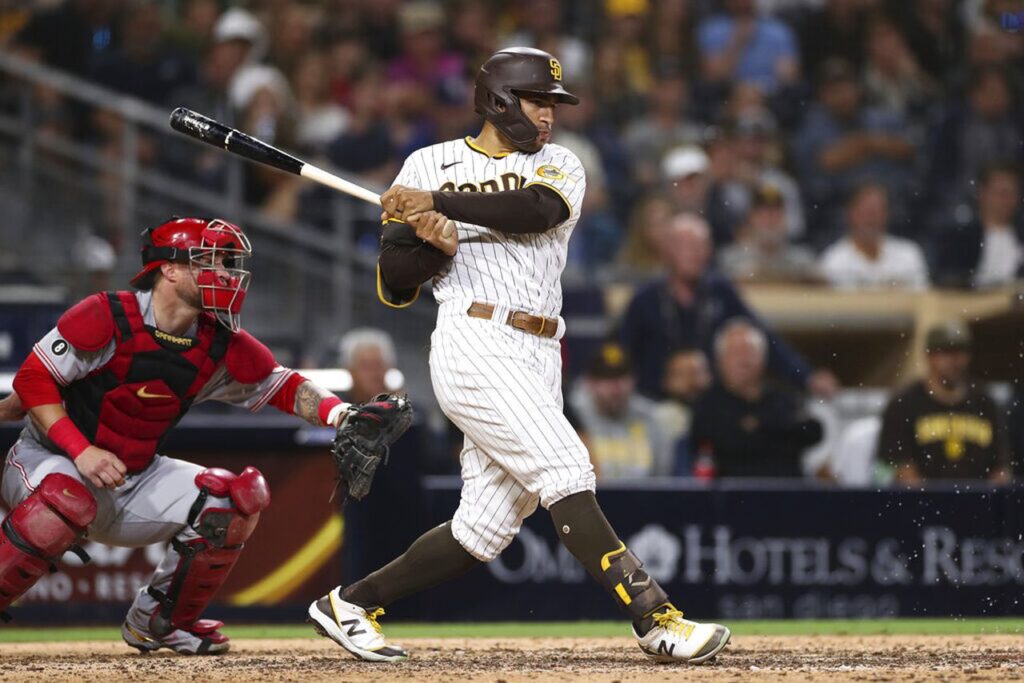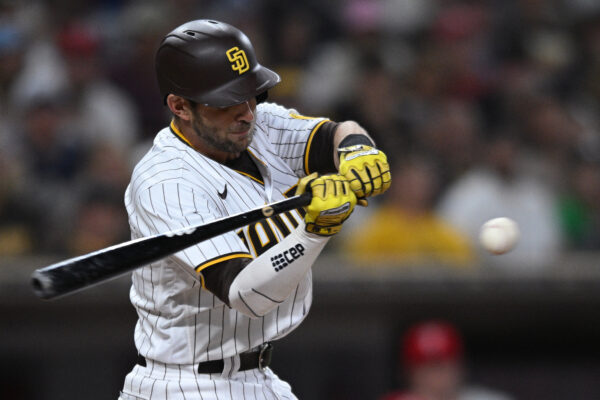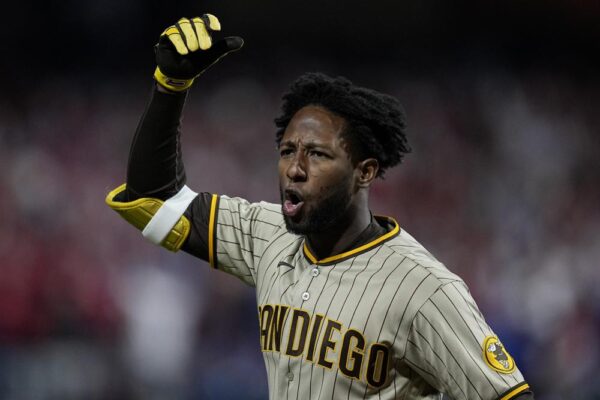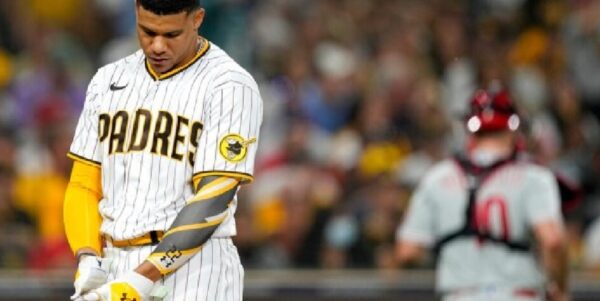In a series filled with missed opportunities, Padres bottom of the order failed to come through

Credit: USA Today Sports

After their crushing season-ending loss in Game 5 of the NLCS to the Philadelphia Phillies, the Padres could look to a multitude of situations where a different decision could have made the difference between a win or a loss.
But, with their season on the brink and trailing by a run in the top of the ninth inning Sunday, the Padres asked their bottom of the order to come through in a big spot. A bottom of the order that Bob Melvin entrusted for the entirety of the postseason, rarely deviating from the same three hitters.
Some may look at the decision as admirable, with Melvin having an undying confidence in his players to come through and make an impact. Others look at it as one of Melvin’s biggest faults, failing to see the need for a change with the season on the line. Similar questions arose after opting to let Mike Clevinger start Game 4 of the NLCS, as well as letting Yu Darvish face Bryson Stott to start the 7th inning of Sunday’s game (Stott doubled then was stranded by Robert Suarez).
After back-to-back one-out walks to Brandon Drury and Ha-Seong Kim, the Phillies chose to turn to lefty Game 3 starter Ranger Suarez to collect the final two outs of the series-clinching game.
The Padres countered by sending Trent Grisham to the plate. Grisham, arguably the MVP of the Wild Card and NLDS rounds of the Padres torrid playoff run, came into the at-bat against Suarez without a hit in the NLCS (0-for-18 with nine strikeouts). On the first pitch from Suarez, Grisham bunted the ball out in front of the plate, fielded by Suarez, and thrown onto first base for the second out of the inning.
On the very next pitch, Austin Nola, who, like Grisham, thrived in the first two series of the postseason before going 1-for-19 in the NLCS, flew out for the third out to end the Padres season.
The inning represented a microcosm of one of the developments that went wrong for the Padres in the NLCS. Much of what the team thrived on in their Wild Card Series win over the Mets and NLDS win over the Dodgers was the ability to lengthen a lineup that had previously shown to be dangerously top-heavy.

After hitting .361 in the first two rounds of the playoffs, Padres’ 7-8-9 hitters in the NLCS hit a combined .091 (5-for-55). Grisham reached base once in the entire series (on an error), and Nola’s lone time on base was after his fifth-inning single in Game 2 against his brother Aaron Nola.
For much of the regular season, the Padres had relied on (primarily) Manny Machado to supplement an offense that ranked in the bottom half of the league in a majority of offensive categories. The team used reliable starting pitching and a deep bullpen to win more than their share of low-scoring games. With the bottom of the order reaching base at a clip above .400 in the first two rounds of the playoffs, it was easy to see how the scope of the team’s offense shifted.
Something else to consider was Melvin’s strong desire to keep a mostly consistent lineup throughout much of the postseason. With the exception of Wil Myers, Drury, and Josh Bell rotating between first base and the DH spot, Melvin did not give a postseason at-bat to any player outside of the regular ten.
Jose Azocar, who took over as the primary center fielder in the latter stages of the regular season, made an appearance as a defensive replacement and scored the go-ahead run in Sunday’s game as a pinch runner for Bell. However, Grisham’s plus defense in center field and his performance in the first two series of the postseason likely earned him a longer leash for the NLCS and a relegation to the bench for Azocar.
The Padres also chose to carry three catchers on the roster for each of their three postseason series. However, backups Jorge Alfaro and Luis Campusano were nowhere to be seen, as neither registered a defensive appearance or at-bat in the entirety of the postseason.
While the matchup of Grisham against Suarez in the ninth inning Sunday may have called for a right-handed hitter, neither Alfaro nor Campusano had received an in-game at-bat since the regular season. Azocar had also already been used, and it would have likely taken some managerial gymnastics to set a competent defensive lineup in the bottom half of the inning should the Padres have taken the lead.

Now, with the official start of the offseason just weeks away, the Padres have questions to answer about each of their bottom of the order hitters. Kim is under contract through the 2024 season and provides plus defense (he received his first Gold Glove finalist nomination last week) and has shown the ability to adjust to Major League pitching. He compiled 4.9 bWAR this season and was can largely be looked at as one of the premier defensive shortstops in baseball.
However, with Fernando Tatis Jr.‘s suspension slated to come to an end on April 20th, 2023, it remains to be seen how the Padres will deploy him defensively after Kim’s emerging season in 2022. Kim figures to be a major part of the Padres plans for 2023 and beyond.
Grisham had the worst MLB season of his young career in 2022, hitting .184/.284/.341 across 524 plate appearances. He, too, similar to Kim, provides plus defense at a premium defensive position while carrying a handful of questions about his ability to provide league-average offense. Also similar to Kim, his playing time may be impacted by Tatis’ return in 2023 as rumors swirl about a return to the outfield.
However, his 17 home runs in 2022 were a career-high, and he is just a two seasons removed from posting a .808 OPS in 2020, though questions will arise about whether that small sample size was a mirage of a greater issue. Grisham is still only 25 and has three more seasons of club control, which makes him an interesting trade candidate if the team chooses to look for premium starting pitching.
Nola, after being acquired for a handful of Padres prospects during the shortened 2020 season, has largely disappointed in his 2 1/2 seasons with the team. Across 665 plate appearances with San Diego, he has hit to a .675 OPS.
[wpedon id=”49075″ align=”right”]
Even so, Nola will likely remain an integral part of the team’s catching plans in 2023. Padres pitchers have continually raved about his ability to handle the pitching staff and his well-timed mound visits. Alfaro is also a free agent, and it is unknown if he will be retained. Campusano remains in waiting and saw slightly more playing time in 2022, but the team remains hesitant to entrust him to handling the pitching staff. Any off-season trade may involve looking for an upgrade at catcher, as General Manager A.J. Preller has shown he is always willing to make a trade at the right price.
Should the Padres retain each of these three players in the offseason, they will likely have prominent roles as contributors on a team expected to contend in 2023. If they are to build on their 2022 season and make a deeper run into the playoffs next year, they’ll need to have a deeper and more productive lineup. The postseason, known for amplifying developments for better and worse, did just that to the Padres 7-8-9 hitters.
Sammy is a 2021 graduate/college baseball player with a degree in economics from Lewis & Clark College in Portland, Oregon. Currently, he resides in a suburb of Portland called Lake Oswego. Sammy previously wrote for EVT from November 2017-November 2019, and is back again as of April 2022.
In his free time, Sammy enjoys spending time outside, playing golf, and watching his hometown Padres.